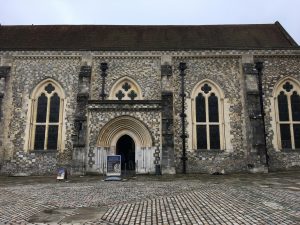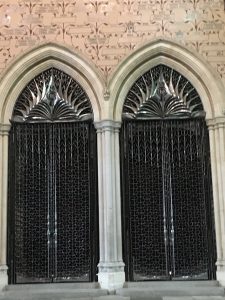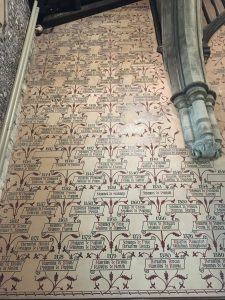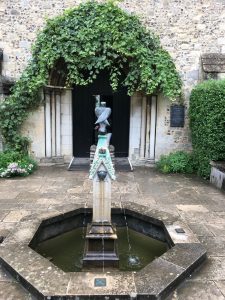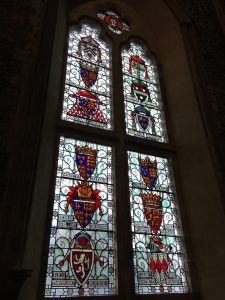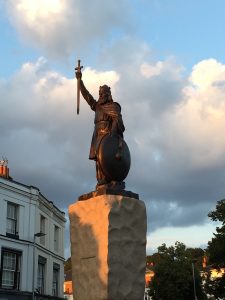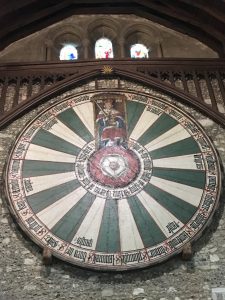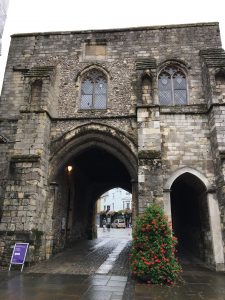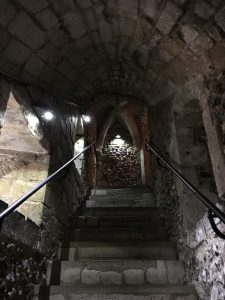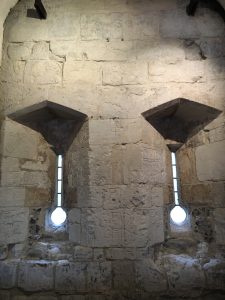The sun disappeared again behind low gray clouds heavy with rain. Makes me sorta miss gray May and June gloom in Los Angeles (which I truly dislike, but is better than this). I set off at midday, when the rain had lessened a bit, to meet a friend I’d met in Australia for lunch.
For those of you who have stuck with this blog you may recall the dreaded BUS trip for 4 days from Perth. Luckily there were two English women on the coach with whom I was able to connect and make the best of a tour that wasn’t what I had thought it would be. One of those women was Valerie, who lives in Dorset. I couldn’t make a trip to her village work with my itinerary, so she generously suggested coming to Winchester for lunch. We had a lovely time catching up and sharing travel stories. I wouldn’t want to top her best story — that of being caught in cyclone Debbie on Hamilton Island in the Whitsundays when it hit in March. She was stuck for 3 days in the hotel without electricity and a terrifying wind, which I understand sounds like the roar of trains, only constant. Obviously she made it out safely, but it was quite an ordeal. Although we hadn’t known each other long, there’s something about traveling together which creates a faster bond. It was a perfect lunch for a rainy day.
From there I headed to The Great Hall, part of Winchester Castle, an enormous fortification begun by William the Conqueror in 1067 and added to considerably by Henry III between 1222 and 1236. Following his death in 1272, Winchester Castle ceased to be a provincial royal palace. The three Edward successors had other things to focus on, and only the Great Hall was kept in repair after a significant fire in 1302. The Great Hall became the center of country administration, and the Castle was fortified during times of civil war strife, but it never regained it’s importance in national affairs. It eventually fell to the Parliamentarians in 1646 and Cromwell ordered the destruction of the Castle, but the Great Hall was able to be salvaged due to it’s role as a county seat.
Today the Hall is mainly a tourist spot, and is known as the home of the Round Table which has hung on the wall by at least the 15thC. The Round Table has been dated from the 13th C, and is 18 feet in diameter, and has 12 holes on the bottom where the legs would’ve been. X-rays show that it has never been painted with any other design; the figure in the center is thought to be a likeliness of King Henry VIII associating him with the legendary King Arthur. The names of his 24 knights are around the outside of the table and there is a Tudor rose in the center. There are many places in England and Wales that claim to be Camelot, and Winchester’s claim comes from it being the capital of Wessex, standing along a river surrounded by plains and forests, having a magnificent cathedral, and of course having a large round table. The statue of King Alfred the Great, who restored Winchester after the Dark Ages and who made it his capital, also seems to add to the mystique and possibility of Winchester as Camelot.
Last stop, the Westgate Museum, housed in one of two surviving gateways of the original five that stood along Winchester’s city walls. The structure is medieval and housed a porter who collected tolls on all goods entering the city and ensured that the gate was closed each night at the curfew bell. Between the 16th and 18th C’s the upper chamber was used as a debtor’s prison and the walls still bear the prisoner’s graffiti, carved in the limestone walls.
And that was my day of visiting and exploration.

